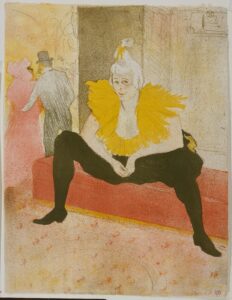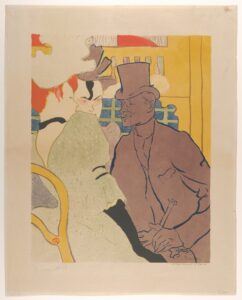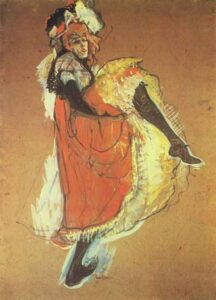 SUMMARY: A new exhibition of Henri de Toulouse-Lautrec’s works at New York’s Museum of Modern Art makes it clear that for Lautrec, the color lithograph, not the painting, was the ultimate work of art. The “how” of the artist’s intense printmaking method is explained by a series of exhibits showing his step-by-step process from rapid sketch to completed print. The works on display exemplify Lautrec’s precision of line and merciless honesty, which, in his renowned depictions of life in the brothel, help underline the essential banality of sin.
SUMMARY: A new exhibition of Henri de Toulouse-Lautrec’s works at New York’s Museum of Modern Art makes it clear that for Lautrec, the color lithograph, not the painting, was the ultimate work of art. The “how” of the artist’s intense printmaking method is explained by a series of exhibits showing his step-by-step process from rapid sketch to completed print. The works on display exemplify Lautrec’s precision of line and merciless honesty, which, in his renowned depictions of life in the brothel, help underline the essential banality of sin.
“Take a line for a walk”, urged the Swiss artist Paul Klee But Henri de Toulouse-Lautrec (1864-1901) went further. He romanced lines, he twirled them and tossed them to the provocative rhythms of the cancan. His legs may have been halt and lame, but his eye and his hand were swift
A recently opened exhibition at New York’s Museum of Modern Art presents a new view of the much romanticized painter and printmaker, usually portrayed as the quintessential Bohemian artist, drowning the pain of his crippled legs in drink and debauchery among the prostitutes and cabaret artists of Montmartre, all the while sketching their self-destructive habits with acid clarity.

The new, rehabilitated Lautrec of the New York show is an earnest fellow who wants only peace and quiet after earning an honest franc in the publishing business. He works long hours and often writes to his mother.
Lautrec doesn’t even portray prostitutes in the nude, as Riva Castleman’s essay in the catalog solemnly points out. Castleman, director of the museum’s prints and illustrated books department and coordinator of the show, argues that Edgar Degas was far more of a sensationalist because he depicted naked prostitutes “in areas of the brothel where it was unlikely they would be unclothed. “Degas visited hounds”, she concludes indignantly, “Lautrec lived in them.”
Lautrec’s movie image is undoubtedly pure hokum. But Castleman does the artist a disservice by trying to put wraps on his keen insights into the essential banality of sin. Dressed in frowsy nighties and too-tight corsets, Lautrec’s prostitutes are infinitely more suggestive of the miseries of their profession than are any of Degas’ angular, athletic nudes,
Lautrec’s drawings, lithographs and oils for his 10-print series “Elles” are devastating precisely because he depicts the life of the brothel with such merciless honesty. From “Awakening”, a deceptively simple color lithograph of a solicitous madam encouraging a hung over girl to rise and shine, to “Reclining Woman, Lassitude”, a print in which the lines themselves exude total exhaustion. Lautrec never allows us to forget exactly where we are and what is happening.
Fortunately, the main point of the show assembled by guest curator Wolfgang Wittrock, is not the rehabilitation of Lautrec.
The more than 300 sketches, photographs, prints, trial proofs and paintings of “Henri de Toulouse-Lautrec: Images of the 1890s” offer a fresh look at the ‘how’ of the artist’s intense printmaking activity. And here the visual evidence does indeed reinforce the view of Lautrec as an indefatigable worker and consummate craftsman.

Lautrec created 368 lithographic prints between 1891 and 1900. Many of the most famous are here in fresh, unbleached versions that restore the luster that has been dimmed by too many tired examples and bad reproductions. In these wonderful prints the lines are crisp, the colors clear and bright. The show also reverses the idea that Lautrec was primarily a painter who made prints on the side. Although two larger paintings are included — “La Gouloue Entering the Moulin Rouge” and “Chilperic” — it is the prints that draw the eye. With the evidence of the sketches, oil studies and numerous trial proofs before you, there is no doubt that Lautrec’s painstaking refinement of his images leads to the color lithograph as the ultimate work of art.
Lautrec’s oil sketch on cardboard for “The Englishman at the Moulin Rouge” (1892) looks as if it were done on the spot. The painting focuses on a top-hatted dandy who is trying to make time with a woman whose back is turned to us. Only his fashionable figure, sharp features and quivering mustache are rendered in any detail; the other figures are rapidly sketched in. In the finished color print, however, the Englishman is in shadow, and the expressions of the woman and her companion have been characterized with care. This final version is infinitely more pointed and sinister. Enclosed by the yellow curve of the woman’s chair and the yellow door frame behind the intent Englishman, the trio seem to be concluding some infinitely dubious transaction. While the print loses the immediacy of the sketch, it is undoubtedly a more balanced, more expressive work of art.
An even more striking comparison can be made between the oil and gouache on cardboard titled “The Large Theater Box”, and the finished print of the same name. All the oil’s extraneous, distracting texture has been deleted in the print. The two women framed by the curving red rims of the theater box have been sharpened in every detail.
The colors in these prints are unusual. There is something acid in their light, clear tones, their flush pinks and feverish yellows. After 1891 Lautrec rejected the yellow, red, blue, black order of printing commonly used in lithography to produce overlapping intermediate tones such as purple or green. Instead, he substituted his own, more intuitive technique. By juxtaposing a number of premixed colors — salmon beige, light red, olive green — he achieved a more individual palette. In “The Englishman at the Moulin Rouge”, for example, Lautrec used six colors.

But much more than the color, it is the quality of line that makes these prints and drawings so compelling. “I have always been a pencil,” Lautrec once said. Of course, he enjoyed the tremendous advantage of living toward the end of one of the world’s great explosions of graphic genius. The French caricaturist and painter Honore Daumier (1808-1879) was his forerunner; and Degas (1834-1917), Edouard Manet (1832-1883) and Constantin Guys (1802-1892) were the elders to whom Lautrec looked for guidance and inspiration. Vincent Van Gogh was his friend and contemporary. It would be hard to find a milieu more conducive to belief in the ability of the line to deliver instant revelation.
While one can see the influence of almost all of these artists on Lautrec’s work in one sketch or another, in subject matter, at least, the most enduring model seems to have been Degas. The generally woman-hating Degas was fascinated by the poor working women of Paris; he loved the unconscious grace of their tired, work-worn bodies. The laundresses, milliners, dancers, circus performers and prostitutes Degas painted became Lautrec’s subjects too, although their tired souls seemed to interest the younger artist more than their bodies.
Even more important, Degas pioneered the café concert painting that Lautrec later made so much his own.
Lautrec openly acknowledged his debt to the older painter. Once at a friend’s dinner party, he led the assembled group into the drawing room, placed them in front of a painting by Degas and said, “This is my dessert.” Unfortunately, Degas did not return Lautrec’s admiration. “He wears my clothes, but they are tailored to his size”, he once remarked in a mean-spirited reference to Lautrec’s small stature.
Degas was wrong. The compressed tailoring of Lautrec’s lithographs came from a different source altogether — Japanese prints. Lautrec learned from the Japanese how to make lines do double and triple duty. With a few swoops of his pencil or brush, he could sharply delineate character, divide his composition into large, easily read masses and impart a sense of vitality and motion. No wonder his very first poster, “Moulin Rouge,” brought Lautrec fame. Its powerful use of silhouette makes other posters of the time look confused and weak. No one before him, not even Daumier, seems to have understood so intuitively the relationship between line and impact in the printer’s art.

This is a timely show in that serious contemporary artists again are employing techniques of commercial printers and finding subjects in the popular arts of the day: film and television. But if these artists find reinforcement in Lautrec’s work, one hopes they also will find inspiration in the honesty of his observations and the ruthless precision of his line. His latter-day descendants seem unutterably bland by comparison.
Jane Addams Allen 1985
Jane Addams Allen was an art critic, publisher and co-founder of the New Art Examiner.
volume 32 no 5 May / June 2018 pp 20-22
